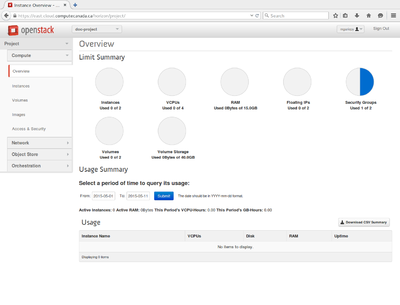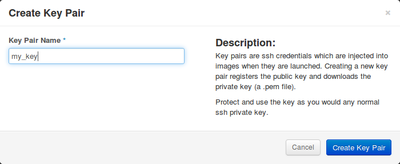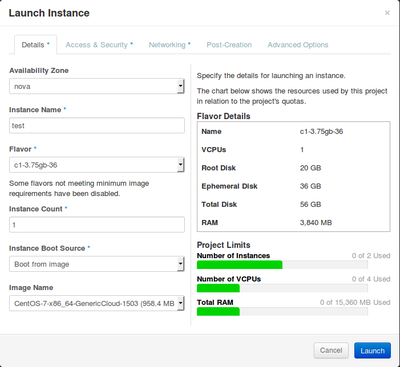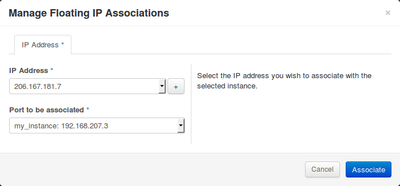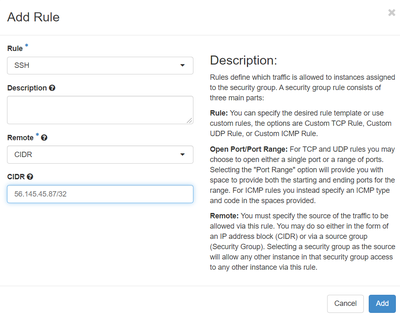Cloud Quick Start
Parent page: Cloud
Getting a cloud account[edit]
1. If you do not have a Compute Canada account, create one with these instructions.
2. Create your cloud account here.
Creating your first virtual machine[edit]
Log into the East or West cloud[edit]
Depending on where your project is located, go to the East cloud or the West cloud and enter your Compute Canada (CCDB) credentials.
When you log in, the OpenStack dashboard shows an overview of your resources.
SSH key pair[edit]
When you start a virtual machine (also often referred to as an instance or a VM), there is no password for an admin or a root account on the virtual machine. This is for security reasons, so that no one can log in with a password (you wouldn't want a hacker to be able to access the brand new virtual machine you just started using some default password...).
OpenStack creates your VM with one SSH public key installed and you can only log in using this SSH key pair. The SSH public key can either come from a key pair which you have already created on some other machine, or can be created by OpenStack. If you are using an existing key pair from a remote machine, you will need to import the SSH public key into OpenStack so that it can be injected into the newly created VM. Alternatively, OpenStack can create a key pair for you with the private key downloaded to your local machine. In order to manage your key pairs, click on Access & Security from the left menu, then on the Key Pairs tab. From here you will have the option of importing an existing key pair, or creating a new key pair.
Importing an existing key pair[edit]
- Click
 ; the Import Key Pair window is displayed.
; the Import Key Pair window is displayed. - Name your key pair.
- Paste your public key.
- Click on the Import Key Pair button.
Creating a new key pair[edit]
- Click on
 ; the Create Key Pair window is displayed.
; the Create Key Pair window is displayed. - Name your key pair.
- Click on the Create Key Pair button.
- Save the <key name>.pem on your disk.
|
Launching a VM[edit]
To create a virtual machine, click on the Instances menu item on the left, then click on ![]()
A form is displayed where you define your virtual machine (if you are following along with this example, you can use the same values).
- Details tab
- Availability Zone: There is only one zone; do not change its name.
- Instance Name: Enter a name for your virtual machine. Rules for valid host names apply.
- Flavor: The flavor defines virtual machine hardware specifications. For a first attempt, pick either 'c1-3.75gb-36' flavor on east-cloud or 'c1-7.5gb-30' flavor on west-cloud. For more details, see Virtual machine flavors.
- Instance Count: Number of virtual machines to create.
- Instance Boot Source: What source should be used to boot the VM.
Boot from image indicates that you wish to boot from an already created image. Another common option is Boot from volume which allows one to boot from an existing volume which is commonly done with "p" flavors.
- Image Name: name of the image to boot from, e.g. CentOS-7-x86-64-GenericCloud-1503.
- Project Limits: The green bars reflect the fraction of your available resources that will be consumed by the VM you are about to launch. If the bars become red, the flavor chosen will consume more resources than your project has available. Blue bars indicate any existing resources your project may be using.
- Access & Security tab
- Key Pair: Select your SSH key pair.
If you have only one, it is selected by default. If you do not have a key pair, please see above Cloud Quick Start#SSH Key Pair.
- Key Pair: Select your SSH key pair.
- Security Groups: Do not remove the check-mark for default.
- Networking tab: Do not change this now.
Networking will be discussed later, after you have launched a virtual machine.
- Post-Creation tab: Do not change this now.
This is where you would paste a cloud-init script which can do things such as install and configure software, add users, and additional SSH keys (see OpenStack#Accessing a VM with Multiple Users) in an automated step after the VM is created. See cloudinit for more details about cloud-init.
- Advanced Options tab: Leave Disk Partition on Automatic for now.
Once you have reviewed all the tabs and defined your virtual machine, click on the Launch button and your virtual machine will be created. The Instances list will be displayed and the Task field will show the current task for the VM; it will likely be spawning initially. Once the VM has spawned it will have the Power State of Running. It may take a few minutes for your virtual machine to start, depending on a variety of factors.
Note: When creating a persistent service, we recommend that you boot your virtual machine from a volume; see Persistent Services In The Cloud.
Network[edit]
Private IP[edit]
On the Instances list are the IP addresses to which your virtual machine is linked. By default, a network on 192.168.X.0 is created for your tenant (also referred to as a project on the OpenStack dashboard).
The list shows your virtual machine's private IP. You can use this IP to communicate with other virtual machines running on the same cloud.
Public IP[edit]
To assign a public IP, you need to select Associate Floating IP from the drop-down menu button (indicated by ▼) of the Actions column in the Instances list. If this is your first time through this Quick Start Guide, your tenant hasn't been assigned an external IP address yet. You need to click on the “+” sign to bring up the Allocate Floating IP dialog box. There is only one pool of public addresses, so the correct pool will already be selected; simply click on the Allocate IP button. The Manage Floating IP Associations screen is displayed, indicating the IP address and the port to which it is NATted; simply click on the Associate button.
Firewall, add rules to allow SSH[edit]
To connect to your virtual machine via SSH, you will need to allow SSH to get through.
- On the Security Groups tab, select Access & Security; on the default row, click

- On the next screen, click

- SSH rules are predefined. Simply select SSH in the Rules dropdown menu and leave CIDR' under Remote.
- If you know which address you are connecting from, type it in the CIDR text field; otherwise leave 0.0.0.0/0. This will allow universal access to your server via SSH.
- Finally, click the Add button.
Connecting to your VM with SSH[edit]
If you created a key pair on the first step, you will need to know where it is.
Connecting from a Linux machine[edit]
[name@server ~]$ ssh -i /path/where/your/key/is/my_key.key username@<public IP of your server>
Most common Linux distributions have standardized on the name of the distro as the username. To connect to the provided CentOS images, you would use:
[name@server ~]$ ssh -i /path/where/your/key/is/my_key.key centos@<public IP of your server>
where <public IP of your server> is the public IP you set in the previous step (Cloud Quick Start#Public IP (Assign a public IP)). The username for Ubuntu instances is ubuntu and Debian instances have the debian username. By default the preconfigured cloud username will have full sudo privileges. The root account is normally disabled.
You are now connected to your virtual machine.
Connecting from a Windows machine[edit]
See Connecting with PuTTY or Connecting with MobaXTerm.
Where to go from here[edit]
- Linux introduction (working with the command line)
- Technical support: cloud@computecanada.ca
- Cloud-init: https://cloudinit.readthedocs.org/en/latest/
- OpenStack upstream documentation: http://docs.openstack.org
- CLI control: http://docs.openstack.org/developer/python-openstackclient/
- WestGrid documentation: https://www.westgrid.ca/support/quickstart/CC-Cloud
